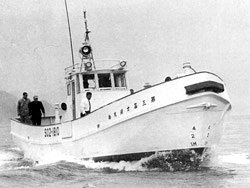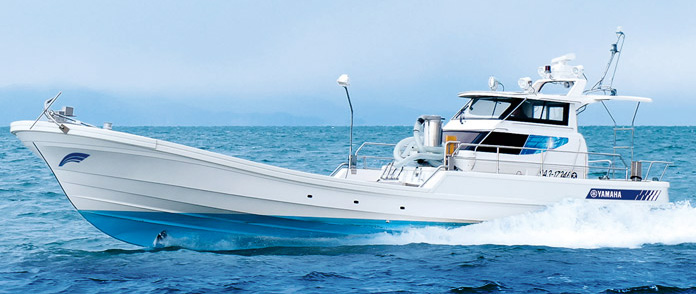FRP Fishing Boats to Carry Seaweed Harvests
Introducing the stories behind Yamaha Motor's technologies.

Our FRP manufacturing technology is actually closely connected to the “gifts of the sea,” from tuna to edible seaweed, or nori in Japanese. Today, the nori aquaculture harvests of the four prefectures in Kyushu with coasts on the Ariake Sea account for about 60% of Japan’s total production. Since 1970, Yamaha FRP fishing boats have played an important supportive role in this industry, and you can see models like the DW-47-0F in operation today, busily plying the waters along the Ariake coast.
The first FRP fishing boat we built and delivered after entering the marine industry in 1960 was an auxiliary craft for the Dai-San Fujiura Maru (#1), a long-line tuna fishing boat. In the case of long-line tuna fishery, an “auxiliary craft” is a boat that is carried aboard a “mothership” to distant fishing grounds in the South Pacific, Indian, or Atlantic oceans. Upon reaching a destination, it is then lowered into the water to perform various tasks during fishing operations. At the time it was built, this auxiliary craft was the largest FRP fishing boat in Japan. She was 16.5 meters long, had a displacement of 19 tons and was powered by a 120 hp diesel engine. Back then, most boats of this class were built of either wood or steel plate, so this new FRP boat attracted a lot of industry attention.
When this auxiliary craft was brought back to Japan every year from the fishing grounds off the coasts of Madagascar, we conducted repairs and maintenance. In the process, we reconfirmed that FRP had the strength and durability to withstand the harsh conditions of ocean fishery. We also identified other areas of improvement to make the hull even better suited to the task. As the conditions of tuna fishery changed with the times and the demand for auxiliary boats like this diminished, Yamaha looked for a new way to make use of the great potential of FRP boats. We found an answer in creating FRP wasen, Japanese-style utility boats without keels used to perform much of the coastal fishery work in the waters surrounding Japan.
To develop these FRP wasen utility boats, Yamaha began by collecting existing wooden versions from the different regions of the country to analyze their performance. Using FRP instead of wood to build boats like these resulted in a weight reduction of 20% to 30%. That alone brought the advantage of faster cruising speeds, but there also emerged a number of issues to deal with, such as boat stability while working on the water and getting enough capacity for the onboard fish tanks (livewell). Once these hurdles were cleared, Yamaha released its first FRP wasen boats in 1968: the W-16 and W-18. Although there was hesitation from fishermen at first about the different feeling the FRP boats had compared to the wooden boats they were used to, the revised W-18A model became very popular among fishermen and went on to become Yamaha’s representative utility boat. Yamaha then followed up by creating utility boat models tailored to the specific needs of fishermen in each region of the country.
Building on the success of these FRP utility boats, Yamaha expanded into constructing FRP fishing boats. At that time, the fishing boats used throughout Japan were hand-built locally by boat-builders known as funadaiku (literally, “boat carpenters”), so every part of the country had fishing boats with a different shape. One exception was the fleet of around 6,000 wooden boats operating in the nori-producing areas of the Ariake Sea; they were virtually all the same shape. This fact prompted us to begin our FRP fishing boat development by creating boats for harvesting seaweed in the Ariake Sea.
With the kind permission of the fishermen, Yamaha engineers were allowed to join them on board as they worked on harvesting the nori. The engineers observed how the fishermen actually worked and looked for possibilities to pursue with FRP fishing boats. The answer the Yamaha team arrived at was to develop fishing boats that could meet the changing needs of the era because marine engine performance was expected to double. In the Ariake Sea area, the seaweed culture grounds were far from the processing factories, so the fishing boats required not only stability while the crew was working and load capacity but also greater speed to ensure the freshness of the nori they delivered. When the difficult demands of the industry were finally met, Yamaha released the DW-40 FRP fishing boat model in 1970. After that, Yamaha rounded out its lineup by introducing its DY Series of multipurpose fishing boats and the DX Series of fishing boats specialized for operating in the Seto Inland Sea. The lineup currently has the DW-430-0B and DW-47-0F models (#2) for harvesting seaweed.
The construction methods and styles of FRP fishing boats have continued to evolve (#3). More recently, there is a “hybrid” mold construction method that joins together a conventionally made FRP mold for the ship’s midsection with molds shaped with 3D computer numerical controlled (CNC) machining technology for the ship’s bow and stern. With CNC machining, the critical shape of the chine of a boat (the line running down the side of a hull near the waterline, and the angle in the hull it forms in relation to the boat’s centerline) can be reliably shaped with millimeter precision in order to design and manufacture hulls that best fit different fishing methods. Yamaha FRP fishing boats made in this way are at work today on the water to help bring quality seafood to our tables.


